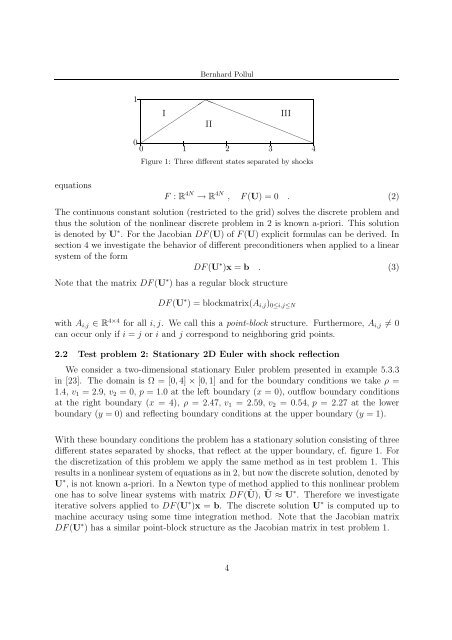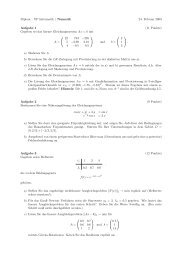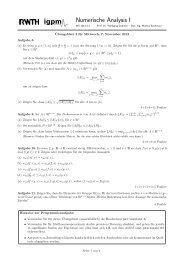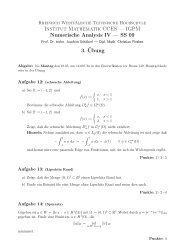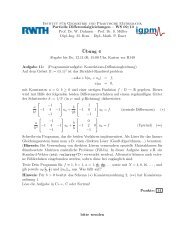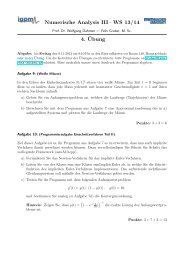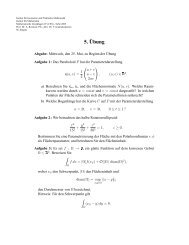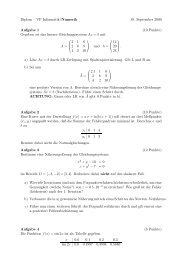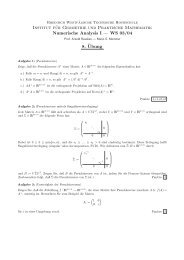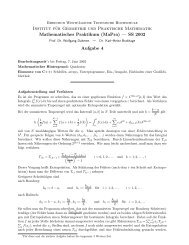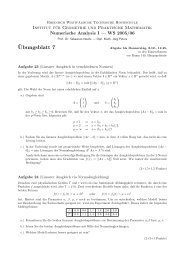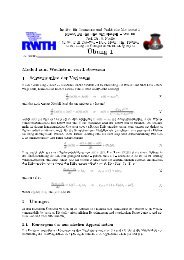preconditioners for linearized discrete compressible euler equations
preconditioners for linearized discrete compressible euler equations
preconditioners for linearized discrete compressible euler equations
You also want an ePaper? Increase the reach of your titles
YUMPU automatically turns print PDFs into web optimized ePapers that Google loves.
Bernhard Pollul<br />
<strong>equations</strong><br />
1<br />
❛<br />
❛<br />
❛<br />
I<br />
❛❛❛ III<br />
❛<br />
II ❛❛❛❛<br />
0 ✑ ✑✑✑✑✑✑✑✑ ❛ ❛ ❛<br />
0 1 2 3 4<br />
Figure 1: Three different states separated by shocks<br />
F : R 4N → R 4N , F(U) = 0 . (2)<br />
The continuous constant solution (restricted to the grid) solves the <strong>discrete</strong> problem and<br />
thus the solution of the nonlinear <strong>discrete</strong> problem in 2 is known a-priori. This solution<br />
is denoted by U ∗ . For the Jacobian DF(U) of F(U) explicit <strong>for</strong>mulas can be derived. In<br />
section 4 we investigate the behavior of different <strong>preconditioners</strong> when applied to a linear<br />
system of the <strong>for</strong>m<br />
DF(U ∗ )x = b . (3)<br />
Note that the matrix DF(U ∗ ) has a regular block structure<br />
DF(U ∗ ) = blockmatrix(A i,j ) 0≤i,j≤N<br />
with A i,j ∈ R 4×4 <strong>for</strong> all i, j. We call this a point-block structure. Furthermore, A i,j ≠ 0<br />
can occur only if i = j or i and j correspond to neighboring grid points.<br />
2.2 Test problem 2: Stationary 2D Euler with shock reflection<br />
We consider a two-dimensional stationary Euler problem presented in example 5.3.3<br />
in [23]. The domain is Ω = [0, 4] × [0, 1] and <strong>for</strong> the boundary conditions we take ρ =<br />
1.4, v 1 = 2.9, v 2 = 0, p = 1.0 at the left boundary (x = 0), outflow boundary conditions<br />
at the right boundary (x = 4), ρ = 2.47, v 1 = 2.59, v 2 = 0.54, p = 2.27 at the lower<br />
boundary (y = 0) and reflecting boundary conditions at the upper boundary (y = 1).<br />
With these boundary conditions the problem has a stationary solution consisting of three<br />
different states separated by shocks, that reflect at the upper boundary, cf. figure 1. For<br />
the discretization of this problem we apply the same method as in test problem 1. This<br />
results in a nonlinear system of <strong>equations</strong> as in 2, but now the <strong>discrete</strong> solution, denoted by<br />
U ∗ , is not known a-priori. In a Newton type of method applied to this nonlinear problem<br />
one has to solve linear systems with matrix DF(Ũ), Ũ ≈ U∗ . There<strong>for</strong>e we investigate<br />
iterative solvers applied to DF(U ∗ )x = b. The <strong>discrete</strong> solution U ∗ is computed up to<br />
machine accuracy using some time integration method. Note that the Jacobian matrix<br />
DF(U ∗ ) has a similar point-block structure as the Jacobian matrix in test problem 1.<br />
4


